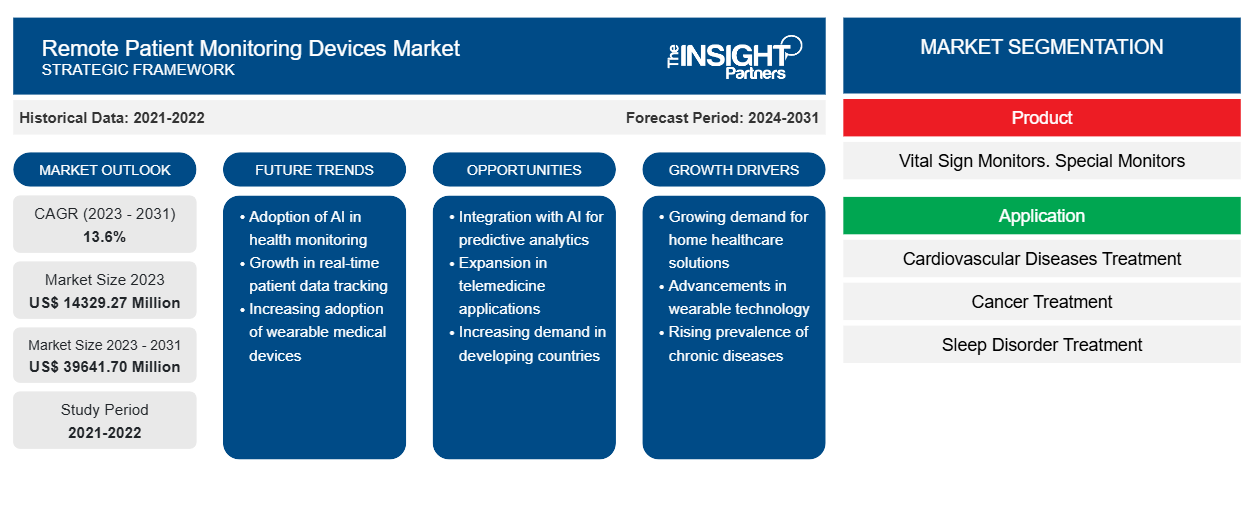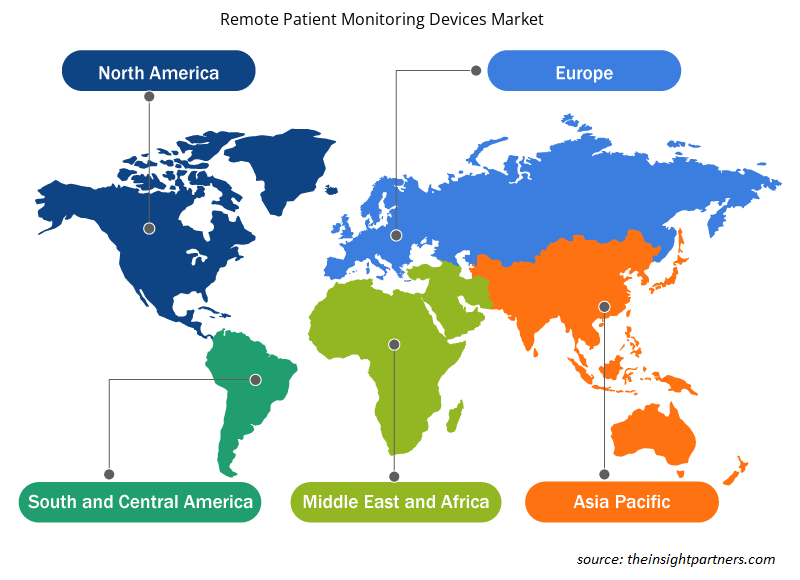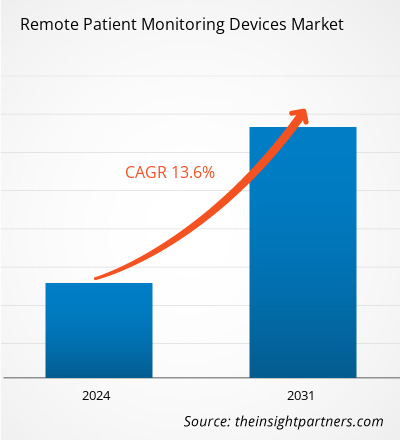The Remote Patient Monitoring Devices Market size was estimated to be US$ 14329.27 million in 2023 and is expected to reach US$ 39641.70 million by 2031; it is estimated to record a CAGR of 13.6% in till 2031. The rising incidence of chronic diseases and increasing awareness regarding healthcare are factors driving the growth of the overall market. In addition, emergence of new local players with competitive product portfolio in emerging countries are expected to fuel the market growth. Such factors are likely to remain key Remote Patient Monitoring Devices Market trends.
Remote Patient Monitoring Devices Market Analysis
Chronic diseases, including heart disease, stroke, diabetes, and obesity, are the leading causes of death in the world and account for most of the nation’s health care costs. According to report of CDC, in 2018, approximately more than 9% of the population has diabetes, which is the leading cause of kidney failure, lower-limb amputations in US. Moreover, the data also suggests that 1.5 million Americans are diagnosed with diabetes every year in the US. Similar trends for high presence of diabetes are prevalent around other geographies of the globe that include Asia Pacific, Europe, Middle East and Africa. For instance, according to IDF Diabetes Atlas published by the International Diabetes Federation in 2017, south-east Asia is home to approximately one-fifth (19%) of the total diabetes population worldwide. According to the report of American College of Cardiology Foundation, in 2018, Coronary heart disease (CHD) was the leading cause of deaths attributable to cardiovascular disease (CVD) in the US, which is followed by stroke (16.8%), high BP (9.4%), heart failure (HF) (9.0%), and other CVDs (17.9%). By 2035, approximately 130 million adults in the US population are projected to have some form of CVD. Thus, increasing geriatric population and related chronic diseases are expected to drive the sales of patient monitoring devices thereby propelling the growth of global remote patient monitoring devices market over the forecast years.
Remote Patient Monitoring Devices Market Overview
Remote patient monitoring (RPM) is a type of telehealth in which healthcare providers monitor patients outside the traditional care setting using digital medical devices, such as weight scales, blood pressure monitors, pulse oximeters, and blood glucose meters. This enables the use of digital technologies to collect health data from a patient in one location and electronically transmit that information securely to a health care provider in another location for evaluation and making treatment decisions.
Global remote patient monitoring devices market is segmented by region into North America, Europe, Asia Pacific, the Middle East & Africa, and South & Central America. In North America, the US is the largest market for remote patient monitoring devices. The US remote patient monitoring devices market is estimated to hold the largest market share during the forecast period in the North American market. The remote patient monitoring devices market growth in the US is attributed to rising aging population in the country. According to the Census.gov, the U.S. population age 65 and over grew nearly five times faster than the total population over the 100 years from 1920 to 2020, according to the 2020 Census. The older population reached 55.8 million or 16.8% of the population of the United States in 2020. With this technology type, elderly patients can be monitored remotely through their phone or tablet without having to visit a hospital or clinic. In addition, continuous technological advancements are further expected to stimulate the growth of remote patient monitoring devices market in North America.
Customize This Report To Suit Your Requirement
You will get customization on any report - free of charge - including parts of this report, or country-level analysis, Excel Data pack, as well as avail great offers and discounts for start-ups & universities
Remote Patient Monitoring Devices Market: Strategic Insights

- Get Top Key Market Trends of this report.This FREE sample will include data analysis, ranging from market trends to estimates and forecasts.
You will get customization on any report - free of charge - including parts of this report, or country-level analysis, Excel Data pack, as well as avail great offers and discounts for start-ups & universities
Remote Patient Monitoring Devices Market: Strategic Insights

- Get Top Key Market Trends of this report.This FREE sample will include data analysis, ranging from market trends to estimates and forecasts.
Remote Patient Monitoring Devices Market Drivers and Opportunities
Rising Awareness Regarding Healthcare
With a rise in cases of chronic illnesses such as diabetes and hypertension, there has been a rise in awareness regarding ones health. Also, in recent days, there has been a significant rise in the number of individuals suffering from heart related disorders. These factors have led to increase in the importance of maintaining health among the population in the developed as well as the developing nations. Also, there has been a rise in number of specialty clinics and home healthcare business in countries such as, US, India, Canada. Asia Pacific is anticipated to offer significant growth opportunity during the forecast period, due to an increase in the disposable income as well as the rate of urbanization in the leading economies such as Japan, China and India. The use of handheld and wearable devices for monitoring vital signs has been high among the old age population as well as millennial. Owing to the growth in awareness regarding health, the market for remote patient monitoring devices is anticipated to witness significant growth during the forecast period.
Technological Advancements – An Opportunity of Remote Patient Monitoring Devices Market
People in Australia and New Zealand are already using digital apps, tools, and services as the preferred way to manage their personal and professional lives. Telehealth remains a constant part of Australia’s health system, which has enhanced access to quality health care for Australians. More than 100 million telehealth services have been provided to 17 million Australians since March 2020. Digital health is an umbrella term indicating a range of technologies that can be used to treat patients and gather and share a person’s health information. Digital health includes mobile health and, electronic prescribing, electronic health records, telemedicine and telehealth, and robotics and artificial intelligence.
According to the Australian Digital Health Agency (ADHA) statistics, the number of records with data in them on My Health Record grew from 5.39 million in January 2019 to 22.31 million in December 2021, with more than 537 million documents uploaded. Monthly views of content on the platform were 476% higher between July and December 2021 (6.08 million avg/month) compared with pre-pandemic views from March 2019 to February 2020 (1.06 million avg/month).
Now and in the future, high-quality digital information remains an important aspect of health care. In particular, improving standardizing and health data development could lead to better information to use and share within the health care system. Such advancements and rising number of players in recent years is likely to generate attractive growth opportunity for the remote patient monitoring devices market.
Remote Patient Monitoring Devices Market Report Segmentation Analysis
Key segments that contributed to the derivation of the Remote Patient Monitoring Devices Market analysis are product and application.
- The global remote patient monitoring devices market, based on product is segmented vital sign monitors and special monitors. In 2023, the special monitors segment held the largest share of the market, by product. This segment is also expected to dominate the market in 2031 owing to increasing technological advancements. Moreover, the special remote patient monitoring segment is anticipated to witness the significant growth rate of 9.1% during the forecast period, 2024 to 2031 owing to rising investments in patient monitoring devices segments from medical devices companies.
- Global remote patient monitoring devices market, based on the application was segmented into cardiovascular diseases treatment, cancer treatment, sleep disorder treatment, diabetes treatment, and weight management & fitness monitoring. In 2023, the cardiovascular diseases treatment segment held the largest share of the market, by application. In addition, the segment is also expected to grow at the fastest rate during the coming years owing to increasing number of the cardiovascular surgeries, increasing number of patients suffering from diseases such as cardiovascular disease, cardiac arrest and cardiac hypertension as they need regular blood pressure monitoring due to frequent fluctuations.
Remote Patient Monitoring Devices Market Share Analysis by Geography
The geographic scope of the Remote Patient Monitoring Devices Market report is mainly segmented into five regions: North America, Asia Pacific, Europe, the Middle East & Africa, and South America/South & Central America.
Asia-Pacific is the third leading region in the global remote patient monitoring devices market. China is holding the largest share in the Asia-Pacific remote patient monitoring devices market during the forecast period. India is expected to witness the highest growth during the forecast period. According to the National Institutes of Health (NIH), approximately 21% of the elderly in India reportedly have at least one chronic disease. Seventeen percent elderly in rural areas and 29% in urban areas suffer from a chronic disease. Hypertension and diabetes account for about 68% of all chronic diseases.
This need is likely to drive the Asia Pacific remote patient monitoring devices market during the forecast period.
Remote Patient Monitoring Devices Market Regional Insights
The regional trends and factors influencing the Remote Patient Monitoring Devices Market throughout the forecast period have been thoroughly explained by the analysts at The Insight Partners. This section also discusses Remote Patient Monitoring Devices Market segments and geography across North America, Europe, Asia Pacific, Middle East and Africa, and South and Central America.

- Get the Regional Specific Data for Remote Patient Monitoring Devices Market
Remote Patient Monitoring Devices Market Report Scope
| Report Attribute | Details |
|---|---|
| Market size in 2023 | US$ 14329.27 Million |
| Market Size by 2031 | US$ 39641.70 Million |
| Global CAGR (2023 - 2031) | 13.6% |
| Historical Data | 2021-2022 |
| Forecast period | 2024-2031 |
| Segments Covered |
By Product
|
| Regions and Countries Covered | North America
|
| Market leaders and key company profiles |
Remote Patient Monitoring Devices Market Players Density: Understanding Its Impact on Business Dynamics
The Remote Patient Monitoring Devices Market is growing rapidly, driven by increasing end-user demand due to factors such as evolving consumer preferences, technological advancements, and greater awareness of the product's benefits. As demand rises, businesses are expanding their offerings, innovating to meet consumer needs, and capitalizing on emerging trends, which further fuels market growth.
Market players density refers to the distribution of firms or companies operating within a particular market or industry. It indicates how many competitors (market players) are present in a given market space relative to its size or total market value.
Major Companies operating in the Remote Patient Monitoring Devices Market are:
- Koninklijke Philips N.V.
- GE Healthcare
- Boston Scientific Corporation
- Omron Healthcare
- Medtronic Plc.
- Welch Allyn
Disclaimer: The companies listed above are not ranked in any particular order.

- Get the Remote Patient Monitoring Devices Market top key players overview
Remote Patient Monitoring Devices Market News and Recent Developments
The Remote Patient Monitoring Devices Market is evaluated by gathering qualitative and quantitative data post primary and secondary research, which includes important corporate publications, association data, and databases. The following is a list of developments in the market for remote patient monitoring devices and strategies:
- In October 2022, GE Healthcare and AMC Health announced a collaboration that allows clinicians to offer Remote Patient Monitoring (RPM) as a virtual care solution that extends patient care outside the hospital to the home environment. (Source: GE Healthcare, Press Releases, 2022)
Remote Patient Monitoring Devices Market Report Coverage and Deliverables
The “Remote Patient Monitoring Devices Market Size and Forecast (2021–2031)” report provides a detailed analysis of the market covering below areas:
- Market size and forecast at global, regional, and country levels for all the key market segments covered under the scope
- Market dynamics such as drivers, restraints, and key opportunities
- Key future trends
- Detailed PEST/Porter’s Five Forces and SWOT analysis
- Global and regional market analysis covering key market trends, major players, regulations, and recent market developments
- Industry landscape and competition analysis covering market concentration, heat map analysis, prominent players, and recent developments
- Detailed company profiles
- Historical Analysis (2 Years), Base Year, Forecast (7 Years) with CAGR
- PEST and SWOT Analysis
- Market Size Value / Volume - Global, Regional, Country
- Industry and Competitive Landscape
- Excel Dataset
Testimonials
Reason to Buy
- Informed Decision-Making
- Understanding Market Dynamics
- Competitive Analysis
- Identifying Emerging Markets
- Customer Insights
- Market Forecasts
- Risk Mitigation
- Boosting Operational Efficiency
- Strategic Planning
- Investment Justification
- Tracking Industry Innovations
- Aligning with Regulatory Trends
Yes! We provide a free sample of the report, which includes Report Scope (Table of Contents), report structure, and selected insights to help you assess the value of the full report. Please click on the "Download Sample" button or contact us to receive your copy.
Absolutely — analyst assistance is part of the package. You can connect with our analyst post-purchase to clarify report insights, methodology or discuss how the findings apply to your business needs.
Once your order is successfully placed, you will receive a confirmation email along with your invoice.
• For published reports: You’ll receive access to the report within 4–6 working hours via a secured email sent to your email.
• For upcoming reports: Your order will be recorded as a pre-booking. Our team will share the estimated release date and keep you informed of any updates. As soon as the report is published, it will be delivered to your registered email.
We offer customization options to align the report with your specific objectives. Whether you need deeper insights into a particular region, industry segment, competitor analysis, or data cut, our research team can tailor the report accordingly. Please share your requirements with us, and we’ll be happy to provide a customized proposal or scope.
The report is available in either PDF format or as an Excel dataset, depending on the license you choose.
The PDF version provides the full analysis and visuals in a ready-to-read format. The Excel dataset includes all underlying data tables for easy manipulation and further analysis.
Please review the license options at checkout or contact us to confirm which formats are included with your purchase.
Our payment process is fully secure and PCI-DSS compliant.
We use trusted and encrypted payment gateways to ensure that all transactions are protected with industry-standard SSL encryption. Your payment details are never stored on our servers and are handled securely by certified third-party processors.
You can make your purchase with confidence, knowing your personal and financial information is safe with us.
Yes, we do offer special pricing for bulk purchases.
If you're interested in purchasing multiple reports, we’re happy to provide a customized bundle offer or volume-based discount tailored to your needs. Please contact our sales team with the list of reports you’re considering, and we’ll share a personalized quote.
Yes, absolutely.
Our team is available to help you make an informed decision. Whether you have questions about the report’s scope, methodology, customization options, or which license suits you best, we’re here to assist. Please reach out to us at sales@theinsightpartners.com, and one of our representatives will get in touch promptly.
Yes, a billing invoice will be automatically generated and sent to your registered email upon successful completion of your purchase.
If you need the invoice in a specific format or require additional details (such as company name, GST, or VAT information), feel free to contact us, and we’ll be happy to assist.
Yes, certainly.
If you encounter any difficulties accessing or receiving your report, our support team is ready to assist you. Simply reach out to us via email or live chat with your order information, and we’ll ensure the issue is resolved quickly so you can access your report without interruption.





















 Get Free Sample For
Get Free Sample For